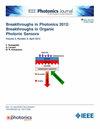Performance Analysis of Multi-UAV Optical Communication Systems Over Foggy Channel Under Málaga Turbulence and Pointing Error Impairments
IF 2.1
4区 工程技术
Q3 ENGINEERING, ELECTRICAL & ELECTRONIC
引用次数: 0
Abstract
Free-space optical (FSO) communication technology is widely utilized in uncrewed aerial vehicle (UAV) communication because it provides larger communication bandwidth than radio frequency technology. However, the system performance of FSO-based UAV communication systems is severely affected by several adverse factors, such as atmospheric turbulence, fog-induced absorption, and pointing errors, all of which result in performance deterioration drastically. This study proposes a multi-UAV optical communication system to suppress the influence of the foggy channel and pointing error impairments under atmospheric turbulence with a Málaga distribution, with both amplify-and-forward (AF) and decode-and-forward (DF) protocols, respectively. Specifically, some critical statistical expressions, such as probability and cumulative density functions, were derived, which were employed to assess the performance metrics, including outage probability, average bit error rate, and ergodic capacity. Additionally, these performance metrics obtained through theoretical analysis in the presence of atmospheric turbulence, fog absorption, and pointing errors were corroborated by Monte Carlo simulations. Finally, the performance indicators under AF and DF relay protocols were compared.马拉加湍流和指向误差影响下多无人机光通信系统在多雾信道上的性能分析
自由空间光学(FSO)通信技术因其比射频技术提供更大的通信带宽而被广泛应用于无人驾驶飞行器(UAV)通信中。然而,基于 FSO 的无人机通信系统的系统性能会受到一些不利因素的严重影响,如大气湍流、雾气吸收和指向误差等,这些因素都会导致性能急剧下降。本研究提出了一种多无人机光通信系统,在马拉加分布的大气湍流条件下,分别采用放大-前向(AF)和解码-前向(DF)协议来抑制雾信道和指向误差损伤的影响。具体而言,推导出了一些关键的统计表达式,如概率和累积密度函数,并利用这些表达式来评估性能指标,包括中断概率、平均误码率和遍历容量。此外,在存在大气湍流、雾气吸收和指向误差的情况下,通过理论分析获得的这些性能指标还得到了蒙特卡罗模拟的证实。最后,比较了 AF 和 DF 中继协议下的性能指标。
本文章由计算机程序翻译,如有差异,请以英文原文为准。
求助全文
约1分钟内获得全文
求助全文
来源期刊

IEEE Photonics Journal
ENGINEERING, ELECTRICAL & ELECTRONIC-OPTICS
CiteScore
4.50
自引率
8.30%
发文量
489
审稿时长
1.4 months
期刊介绍:
Breakthroughs in the generation of light and in its control and utilization have given rise to the field of Photonics, a rapidly expanding area of science and technology with major technological and economic impact. Photonics integrates quantum electronics and optics to accelerate progress in the generation of novel photon sources and in their utilization in emerging applications at the micro and nano scales spanning from the far-infrared/THz to the x-ray region of the electromagnetic spectrum. IEEE Photonics Journal is an online-only journal dedicated to the rapid disclosure of top-quality peer-reviewed research at the forefront of all areas of photonics. Contributions addressing issues ranging from fundamental understanding to emerging technologies and applications are within the scope of the Journal. The Journal includes topics in: Photon sources from far infrared to X-rays, Photonics materials and engineered photonic structures, Integrated optics and optoelectronic, Ultrafast, attosecond, high field and short wavelength photonics, Biophotonics, including DNA photonics, Nanophotonics, Magnetophotonics, Fundamentals of light propagation and interaction; nonlinear effects, Optical data storage, Fiber optics and optical communications devices, systems, and technologies, Micro Opto Electro Mechanical Systems (MOEMS), Microwave photonics, Optical Sensors.
 求助内容:
求助内容: 应助结果提醒方式:
应助结果提醒方式:


